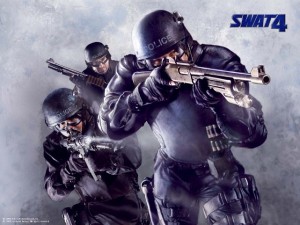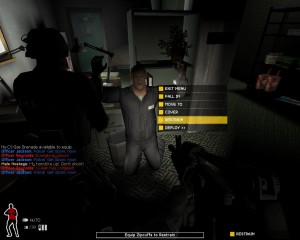
Game Website: http://www.mobygames.com/game/swat-4
Gameplay Video: https://www.youtube.com/watch?v=-Zg4OMScy7g
Description: SWAT 4 is a first-person shooter that requires the use of realistic squad-based police procedures to resolve hostage stand-off situations. Players may outfit their squad and plan their approaches as they deem fit. Scoring is based on how strictly players follow proper police procedures.
My Experience
The Elemental Tetrad
- SWAT 4’s graphics are realistic enough for my immersion and suspension of disbelief, with detailed items, locations & NPCs.
- As I pieced the story together, touches like a mass grave of babies in a cultist’s house got me emotionally engaged.

- SWAT 4’s mechanics were precise, and I felt in control due to the many commands I could easily give for any situation. However, AI SWAT members often got in my way and complained, making it rather irritating and causing quite a few accidental deaths.
- The technology in SWAT 4 was put to good use, as NPC enemies all had their own personalities. AI team members also knew different procedures and executed them independently in context.
The Lens of Projection
- SWAT 4 made me feel like a SWAT leader, following police procedures, and aiming to minimize hostile casualties.
- I could relate to real-life police as I arrested the baby-killer, furious as I saw their graves. I gave the suspect an unnecessary taser shot to express my disgust, and had to actively restrain myself from further brutality.
The Lens of Skill vs Chance
- Each SWAT 4 scenario is randomly generated, such as enemy placement and personalities. I took a very cautious approach, skilfully checking each room to minimize casualties. However, there were still times when I was surprised by hostiles rushing in. Thus with skill, I mitigated the problem of chance disadvantages.
The Lens of Control
- I opted to outfit my each member with non-lethal weapons, and commanded them as a team and individually with a few clicks. This made me feel masterfully in control as I directed each element and executed my grand plan for storming a toilet. The interface was not deficient in options and mastered quickly.
The Lens of Rules
- I followed the ‘rules’ of SWAT 4 closely. These rules are not strictly enforced, and your score will be reviewed at the end of the game with no consequences. Hence, the rules are rather up to the player, who enforces them on himself to get the highest score.
The Lens of Challenge
- I was constantly challenged as enemies started wearing armour and getting more plentiful. I had to devise new strategies to deal with more professional hostiles, but also had more tools like snipers. The scoring also left the challenge up to me, where I aimed for 100% perfection in each scenario.
My Brother’s Experience
The Elemental Tetrad
- SWAT 4’s graphics are realistic enough for my brother, who enjoyed the blood spatter effects immensely. He had a great deal of fun trying to paint on the wall by shooting a corpse in a certain manner.
- My brother entirely disregarded the story, and just wanted to kill everybody. His fun came from the pure emotional detachment from the seriousness of the game’s story.
- My brother explored every mechanic SWAT 4 presented, but ultimately stuck to a true-and-tested formula of gassing the room and then shooting everybody who resisted.
- The technology in SWAT 4 was great, and the NPC hostiles adapted quickly to my brother’s careless playing style through mock-surrendering and suicidal attacks.
The Lens of Projection
- As my brother skipped briefings and also disregarded the subtle story artifacts that the player discovers through the level, he did not feel as much immersion as I did. However, he did still feel empathetic towards injured hostages, opting to rescue them quickly – perhaps due to his background as a first aider. He would however, still get angry when he or his teammates were shot by hostiles, and would project himself into the game scenario rather than into the character.
The Lens of Skill vs Chance
- My brother did not approach SWAT 4 with much caution, and the random placement of enemies frustrated him as he was constantly surprised. However, he soon learnt to play at the minimal skill level to survive while maintaining as much reckless excitement as he could.
The Lens of Control
- My brother did not bother to take full advantage of the equipment outfitting options, and often lamented the lack of specific tactical equipment he needed as he progressed. He also felt frustrated that he could not control the situation as hostiles hid in tactically advantageous spots, and would sometimes restart the level to get a more favourable scenario.
The Lens of Rules
- My brother did not follow proper police procedures closely, and often did the bare minimum in order not to fail a level. However, he had a lot of fun bullying suspects or shooting his own teammates – his rule being that you could do anything to have fun as long as you did not die or get less than 50%.
The Lens of Challenge
- My brother was constantly challenged by enemies adapting to his recklessness. As he formed his own rules, he also formed his own challenges – such as killing all his teammates and completing a level solo. Upon being stuck due to good enemy positions, he would get frustrated and rush into the room, then quit or restart once he inevitably died. He preferred playing custom games where he could set the number and skill of enemy hostiles himself.
Analysis
Background of Players (Projection & Skill)
I realised that the existing knowledge and background of the player is important in game design. As I was formerly trained in urban combat operations, I understood the best way to minimise casualties. I made full use of the options available to me for each situation, and felt very immersed in a familiar role. However, my brother did not as he had yet to enter the military, but had experience as a first-aider. This affected what roles the players projected themselves into (police vs himself), the skills available to them (urban ops vs Call of Duty-style rushing), and the challenge they faced (perfect scores vs frustration, game-rigging and restarts).
Subtle vs Direct Elements (Story, Skill, Rules)
I learnt that not all players could identify subtle gameplay/story elements, and needed to have them directly highlighted to them. I enjoyed SWAT 4’s story immensely, taking the time I used to scope out a room to also take in any evidence/artifacts. I also paid attention to the text-based briefings so that I could plan my approach with the intelligence. However, these were all missed by my brother, who wanted to get into the action. I believe that he would also be able to enjoy the story had they been presented in a more direct manner, such as through cutscenes or objectives, or even through AI teammates making story-specific remarks.
My brother’s lack of military background also resulted in poorer skills. While the game did have a tutorial level on the mechanics available, it did not explicitly go through other rules such as police and military procedures/tactics. This was slowly picked up by my brother the hard way, or with my coaching. Hence, the game is deficient in its assumption of its players. If a player’s initial frustration due to a lack of skill and success leads him to quit the game, then it would not have been successful. However, SWAT 4 prevents this with its flexibility and customisability.
Designing for Various Play Styles (Challenge)
I realised that SWAT 4’s flexibility allowed my brother to continue playing despite his initial frustration. He could customise enemies to fit what he wanted to play (A Call of Duty-style shooter), and there were no hard and fast objectives to meet. He could indeed, find success by using an entirely different approach from myself (lethal vs non-lethal). The vast array of lethal weapons and explosives available were also put to good use by him, while I did not even try out any of them. Thus, SWAT 4 was well-designed for different types of players in mind.
I felt that SWAT 4 could be even better designed with different built-in game modes, a sort of pre-set for their custom games. This would allow players to immediately choose what they wanted. However, even if players opted for vanilla SWAT 4, the AI does an incredible job of adapting to the play-style on the fly. This keeps the challenge up and the gameplay fresh.
Error Recovery
I found that SWAT 4 might have a steeper learning curve for those without police/military backgrounds due to the tactics they have to devise. Furthermore, health was not recoverable, and teammates stayed dead. Ammo could also not be picked up. Hence, a wrong step early in the game could lead to quick failure, and players are not able to recover from their mistakes. Hence, rather than basing game difficulty on the minimum score required in each play, SWAT 4 could have allowed beginners to recover and learn from early mistakes by featuring things such as regenerating health, calling for more backup or ammo. This would reduce beginners’ frustrations while they learn.
Controls, Controls, Controls
Lastly, what impressed me most about SWAT 4 are its controls. With an easily navigable control interface, even unskilled players could quickly and easily do what they wanted. The menus were contextual, logically grouped and colour-coded for superior control and feedback. Hence, this is something I would spend a considerable amount of time planning and aiming towards when designing a game.
-Daryl Lim

